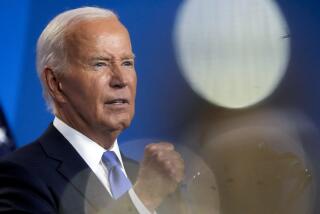Even a Draft Blows the Wrong Way : Politics: Will a late bloomer thrust forward at the convention to save the Democrats?
- Share via
Urging prominent Democrats to seek the party’s nomination is as daunting as getting volunteers to be first into a nuclear reactor after a meltdown. But if few have the stomach to challenge George Bush, couldn’t some reluctant figure be drafted for the good of the party?
Historically, drafts have taken place at conventions where several candidates have comparable numbers of delegates votes but none has enough to be nominated. The 1880 GOP convention saw Sens. James G. Blaine of Maine, John Sherman of Ohio and former President Ulysses S. Grant all with roughly equal strength.
After 35 ballots without a nominee, delegates turned to a young Ohio senator, James A. Garfield. Virtually the same scenario occurred in 1952, when Democrats met in Chicago. The leading hopefuls were Sen. Estes Kefauver of Tennessee, Sen.Robert Kerr of Oklahoma and New York Gov. W. Averill Harriman.
Kefauver, the odds-on favorite, was unpopular with party professionals, but their preferred candidates would have been unappealing to voters, so a campaign began to draft the convention host, Illinois Gov. Adlai E. Stevenson. Initially cold to the idea, Stevenson acquiesced when persuaded that a weak candidate would give Congress to the GOP and elevate the hated Ohio Republican Robert A. Taft to Senate leadership.
Drafts are unlikely today because conventions have become coronations rather than places where important decisions are made. Any last-minute candidate who had not faced the voters in a primary would have legitimacy problems.
But if there was any year shaping up as favorable for a draft, it would be 1992. The only declared candidate, former Sen. Paul E. Tsongas of Massachusetts, has generated little enthusiasm. Possible future entrants--Sen. Tom Harkin of Iowa, Sen. Bob Kerrey of Nebraska and Gov. Bill Clinton of Arkansas--are familiar only to the political cognoscenti, so it seems conceivable that a standoff--the optimal condition for a draft--might develop.
Moreover, the number of “super-delegates”--Democratic officeholders and party leaders officially uncommitted at convention time--has been boosted to more than 17% of all delegates. If favorite-son candidates from populous states--Gov. Mario Cuomo of New York and Gov. Lawton Chiles of Florida, along with favorite daughter Gov. Ann W. Richards of Texas--were in contention, a stalemate might be engineered as a prelude to adraft.
But whom to draft? Here again, recent political changes have also limited the possibilities. Years ago, some good soldier could always be found to sacrifice for the party, but self-immolation in a losing cause has little appeal to today’s politicians. Party leaders today are neither as powerful nor as persuasive as they once were. And the one person who might hold himself open to a draft, the Rev. Jesse L. Jackson, is too divisive a figure to achieve consensus.
So even if all the political planets are in proper alignment in 1992, would-be drafters are apt to hear the echo of Gen. William Tecumseh Sherman, who was approached in a draft effort in 1884: “If nominated I will not run. If elected, I will not serve.”
More to Read
Get the L.A. Times Politics newsletter
Deeply reported insights into legislation, politics and policy from Sacramento, Washington and beyond. In your inbox twice per week.
You may occasionally receive promotional content from the Los Angeles Times.










